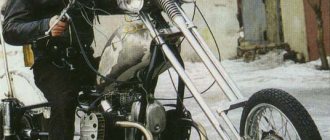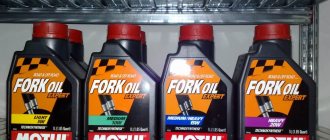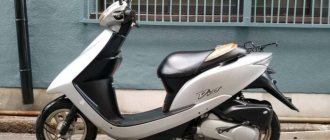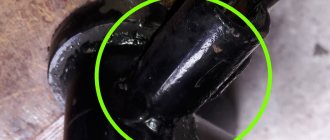Inverted fork.
An inverted telescopic fork, in which the upper tubes are fixed and have a larger diameter than the lower ones, allows for better chassis rigidity and, accordingly, maximum handling.
The tube and yoke for the shock-absorbing tubes are made of aluminum, which provides excellent rigidity to the structure. At the same time, the unsprung masses of this design are no higher than those of a conventional fork. Although the internal dip tubes have a smaller diameter than conventional inverted dip tubes, they are made of heavy-duty steel.
For example, the Marzocchi inverted fork used on the BMW F 800 GS with anodized aluminum fixed fork tubes and magnesium alloy steerers with a diameter of 45 mm provides excellent response and maximum stability even under high loads. Shock tube crossbars guide more torsion-resistant, larger-diameter outer tubes.
The BMW S 1000 RR uses an inverted fork with a 46 mm steerer diameter. This larger size provides significantly greater braking stability than the conventional 43mm size, as well as sharper cornering response – also thanks to the forged aluminum connecting bars.
By the way, an inverted fork often allows you to change the height of the front of the motorcycle. For the S 1000 RR it varies within a range of 15 mm: the motorcycle can be lowered by 5 mm compared to the standard position or raised by 10 mm. In addition, you can change the compression and rebound characteristics. The total spring stroke is 120 mm, of which 75 mm is positive and 45 mm is negative spring stroke. Settings from 1 to 10 are available for easy adjustment of spring preload and compression and rebound damping.
Manufacturers
When choosing a suspension fork for a bike, you should pay attention to the following companies producing components:
- Fox is a manufacturer that produces professional components. Characterized by high quality elements;
- Marzocchi is an Italian company that makes good forks. In recent years, the quality of products has dropped. Costs remain high;
- RockShox makes good quality forks. A popular company among riders. Almost any bike repair shop can fix the damage;
- DTSwiss is a Swiss manufacturer. Relatively new on the bike fork market. Has good quality. The characteristics are not inferior to analogues.
Motorcycle fork
When BMW specialists developed a telescopic fork with a built-in hydraulic shock absorber in the mid-30s, they hardly imagined that this unit would become an indispensable accessory of any motorcycle.
A modern telescope is lightweight, compact and durable; it simultaneously performs the functions of suspension and steering. This is a plus. Its disadvantages are a direct continuation of its advantages: the limit of universality is the best combination of the worst options.
What is wrong with the traditional telescopic fork? Look at the motorcycle from the side. Do you see this terrible picture: contrasting with the tightly built appearance of the motorcycle is the painfully fragile reed connecting the main mass with the front wheel? Its strength (primarily torsional rigidity) is the main factor influencing the handling of a modern high-speed car. In addition, the reed acts as a lever, multiplying all the braking forces and shocks from road irregularities transmitted to the frame. Therefore, you have to strengthen the unit adjacent to the steering column... and pay the price by increasing its mass.
This is not the only drawback of the telescope . Friction of the pipe-on-pipe type (it is aggravated by the bending action of the fork) leads to an increase in the amount of initial force required to activate the suspension - therefore, the fork does not handle small road irregularities well. The combination of several functions in a compact unit makes it difficult to adjust both the spring preload and the hydraulic compression and rebound forces. And most importantly , when the suspension operates, the geometric parameters of the chassis change, which does not have the best effect on handling.
It would seem that the strength of the front fork can be achieved simply by increasing the diameter of the supporting pipes. But there are pitfalls here. Firstly, the mass of the unit increases - primarily unsprung (which is fraught with a deterioration in the response to road irregularities). Secondly, as the diameter increases , the contact areas increase, and this leads to an increase in the initial actuation force of the fork.
When the solution to a puzzling problem is finally found, exclamations are heard: This is elementary. And it dawned on the specialists of the Dutch company WP: what if you take a fork and turn it over? In a traditional telescopic one, the diameter of the lower sliding pipes to which the wheel is attached is larger than the diameter of the supporting ones. In the design , which immediately received the name upside-down or inverted, everything is the other way around: the supporting pipes are larger in diameter than the sliding pipes
Atypical models
In addition to shock-absorbing forks of the classical design, there are “changers”.
They are arranged according to the same principle, but upside down, i.e. their pistons are at the bottom. The advantages of this solution are increased strength, improved grip on the road surface, and better handling of uneven surfaces. But “reversals” are heavier, more expensive and more susceptible to piston contamination.
There are atypical forks with an increased number of pistons and levers, models with 1 leg and other innovative solutions.
Depreciation (shock-absorbed)
This large category includes soft models that are equipped with a shock absorber. Three elements can act as a shock absorber: spring, oil and/or air. They can be combined or used separately, which significantly affects the cost of the fork and the level of its performance. Such forks are actively installed on bicycles.
Shock-absorbing structures are available in a huge range. Models vary significantly in price, quality and durability. The most inexpensive forks are equipped with spring-type shock absorbers and low-quality consumables. There can be no talk of any adjustments, although some sellers manage to pass off the rotating plugs as adjustment elements. You can’t choose a product like this and expect long-term performance. In fact, after just a short time you will feel irritated by the inadequate operation of the mechanism.
Suspension bicycle fork
Advantages and disadvantages
For a more reliable and durable plug you will have to pay about 3 thousand rubles. The amount is considerable, but high quality cannot be cheap. Moreover, in addition, you get a number of advantages that low-end models do not have:
- reduction of shock and vibration load that goes to the front of the bike;
- neutralization of the “braking effect” that occurs during road irregularities;
- improved handling;
- increasing the service life of a number of important structural components;
- maintaining high speed on bad roads.
Agree that you can overpay for such a set of advantages. This barrel of honey is missing a fly in the ointment. The list of shortcomings is as follows:
- heavy weight, which can reach 3 kg;
- wasting energy and speed when rocking a bicycle.
A good fork reduces shock and vibration load, neutralizes the “braking effect”, improves handling and much more.
Manufacturers are constantly working to improve their products, improve their characteristics and reduce existing shortcomings. Therefore, the forks become lighter and can be adjusted at the user’s discretion.
After modifications
The fork looks like this:
On a bike it looks like this:
The inscription " Himalo"
"was carefully cut with a blade using masking tape as cutting guides (cut because the fork has little in common with this manufacturer, and the name does not look nice, but simple graphics, not flashy, look better). The pressure adjustment in the cartridge practically does not stick out, which is a plus, the lid perfectly matched the color palette of the fork, rubber rings were installed on the threaded connections at the bottom of the pants so that oil would not leak out from under the threads. The fork is ready to be installed on the bike.
Testing
Well, what you’ve all been waiting for a long time, namely action!
Let's go for a ride. Before the video of the work, I will first show how the fork coped with the baptism of fire. Namely, when I was skating in a skate park, at the exit from the quarter my wheel blew off, and I grinded the fork’s foot along the metal edge of the quarter, I thought that was it, the end of the anode, but the anode survived only with a slight dent:
It is located in the upper part of the working stroke, so it is not critical. You can hardly feel it with your finger, as if it was slightly matted with sandpaper, I think you can polish it with a zero or even hammer it in, the fork is Chinese 
Since the tracks have not yet dried, and rolling and destroying them when they are wet is bad manners (you’ll have to fix them yourself later), I’ll show you my everyday route to work, small drops, forest marches, I think it will be enough to evaluate.
Current settings: 1. left leg with air spring - 120 PSI, 2. right leg - 200 PSI in cartridge, 3. rebound set to medium.
Meter-long drop into the flat and flight of stairs:
Hills and a long flight of stairs in 3 flights:
Principle of operation
Before rating mountain bike forks, let’s look at how they work. When pressing on the steering wheel when driving over holes, bumps and other road irregularities, the internal pipes experience the resistance of the spring and are inserted into its legs. When a shock load occurs, the spring absorbs it and absorbs it inside the structure. When vibrations occur, the damper performs the damping task. Thanks to it, the spring does not immediately move back, but moves gradually, without jerking. Therefore, even with an aggressive riding style and traveling in difficult road conditions, a smooth ride is maintained.
How to care
To extend the service life of any component, certain care is important. Required:
- once every 100 kilometers the part needs to be cleaned and lubricated;
- regularly monitor the integrity of the pants;
- every 500 kilometers lubricate the oil seals;
- Change the oil annually if its presence involves a shock absorber.
You should not forget to clean the fork from external dirt after each ride, which will reduce the likelihood of dust and dirt getting into the oil. When servicing the suspension fork, you will need the following tools:
- screwdriver;
- pliers;
- a set of keys;
- When working with oil filling, gloves and rags.
Finalization
Improvement No. 1 - making a new rod in step with the air:
I sketched out a minimal drawing of the extended rod:
As a result, this is the stock that came out of the D16T:
Here in comparison with the complete one:
Short negative spring, works normally only when the factory short rod is installed. With a long stem and spacers, when the fork came back, a characteristic click was heard. This is not acceptable and the air spring design itself has been revised. Now it is based on the operating principle of Manitou forks, namely, the negative spring was selected according to the length and weight of the rider.
Now the whole assembly looks like this, the length of the spring was 135mm, after trimming, the end of the spring was annealed under load and polished, and heat shrink was put on the spring so that it would not knock:
I also put a rubber bumper on the end of the bar, which originally stood inside the leg:
As a result, the travel became 180mm, as originally wanted, while each of the legs rests its entire area on a pair of bushings, the geometry of the fork is not broken, the travel is free and does not bite. Now you can pump pressure up to 120 PSI, while the negative spring allows the fork to take off easier, as well as adjust the sag. Finally the air spring worked as it should. It began to resemble the work of Manitou forks.
This completes the overclocking work.
Modification No. 2 installation of a nipple for pumping into the damper expansion tank:
Inserting the nipple for pumping into the cartridge:
I took the image of the cartridge from the Velomania forum, thanks to them for the diagram, albeit an approximate one, I put the names of the parts on it for understanding:
The modification boils down to inserting a shredder nipple into the nitrogen end to pump up the chamber and then adjust the pressure of the floating piston; we also need to cut the extension by 20 mm to eliminate unnecessary load on the cartridge and reduce the length of the closed cartridge body, thereby increasing the working rod stroke:
Then I tried to unscrew the extension and nothing came of it, so I decided to cut it off and immediately drill a hole in the end of the cartridge screw, thread size M8 x 1.25. And then it dawned on me, the short rod that came with the fork has the same thread and it is through, so we use it for modification, at the same time we’ll lose a little weight because there’s no point at all in such a thick extension:
And don’t forget one nuance: when you drill a hole in the end of the damper, then you need to wash it. Fill the oil from the syringe and work the piston with progressive movements. The air piston does not reach the very bottom of the cartridge, so the chance of damaging it is minimal. And also don’t forget to put glasses on your eyes when you drill the cartridge, as oil may splash out of the cartridge along with nitrogen, and this will be very unpleasant.
I cut off the excess from the rod and screwed a new extension onto the damper:
The metal thickness of the new extension is 4mm, which in general will be sufficient for rigidity + it is possible to cut a thread for the nipple:
I cut a thread for the shredder nipple, and assembled all the threaded connections with epoxy resin:
Now the pressure in the cartridge is regulated, pumped it up and checked it. Holds perfectly up to 200psi, and you don’t need more.
After the modification, the volume of the damper compensation chamber increased. Different pressures in the chamber will give different results, namely, the compression progressiveness setting will change, and also due to the increased volume of the chamber, the damper will be cooled better. This is a very good and useful modification that will extend the life of the rubber bands inside the damper; I also recommend pouring 3 ml of silicone oil into the air chamber.
Improvement No. 3 adjustment of rebound adjustment (rebound):
Adjusting the rebound (rebound) for high speed:
Let's first look at the adjustment itself and see what's inside:
Inside is a simple hexagon with a locking ring; twist the hexagon to raise/lower the needle, which blocks the inlet holes in the piston and thereby regulates the compression speed. To get the fastest possible compression/release, you need to slightly trim the screw-bushing, the needle will rise higher, the rebound speed will increase, cut it by 4 mm:
Then, so that the adjustment knob does not dangle, we put a small spring on the hexagon:
And put the handle back:
What has changed? And it’s simple, the needle adjustment range shifted from fast to slow, I didn’t regret one bit that I lost the very slow rebound (rebound), because I don’t see any situations for its use.
One more point:
Modifications 2 and 3 can be used in Zoom 680DH forks.
Improvement No. 4 installation of Fox bushings
The new FOX bushings were installed in their mounting holes, the only thing was that the upper bushings stood up after I glued the aluminum tape in a circle in one layer, only after that everything stood up well. Now my feet glide just great.
Modification No. 5 installation of foam rings under the boot
Well, the obligatory completion of work with the pants is the installation of foam rings, which are saturated with fork oil and, in fact, are an additional means for lubricating the legs, as well as protecting the insides of the fork from dust.
I bought rings within 5 minutes of availability, took some from a 36mm fox, 5mm high. Of course they are a bit tall, but oh well. I soaked them in oil, installed them and pressed the boot.
They work, the leg is lubricated, the boot fits perfectly and does not fly out, the ring, of course, shrank a little under it, but overall everything is ok.
Improvement No. 6 setting the progression settings in step with the air
There is an idea to integrate an IRT piston in step with the air in order to obtain a progression at the end of the stroke, as implemented in Manitou Mattoc pro. Quite ambitious and while I won’t deal with it, you can buy an original kit from Manitou for Mattoc and it will fit almost completely (I checked with a friend, unscrewed the topcap with IRT and tried to screw it into the Chinese one, it fit, but I need to seal the threads with something) .
This is what the IRT kit looks like:
Main components
No matter how different the suspension forks are, their design has a similar composition:
- A spring that provides compression and neutralizes the main load. Available in three versions: steel, pneumatic, titanium.
- The damper is responsible for damping vibrations, which is achieved by rapid compression and slow return to its original state. It is also available in three versions: air, elastomeric and oil.
- Damper control mechanism.










